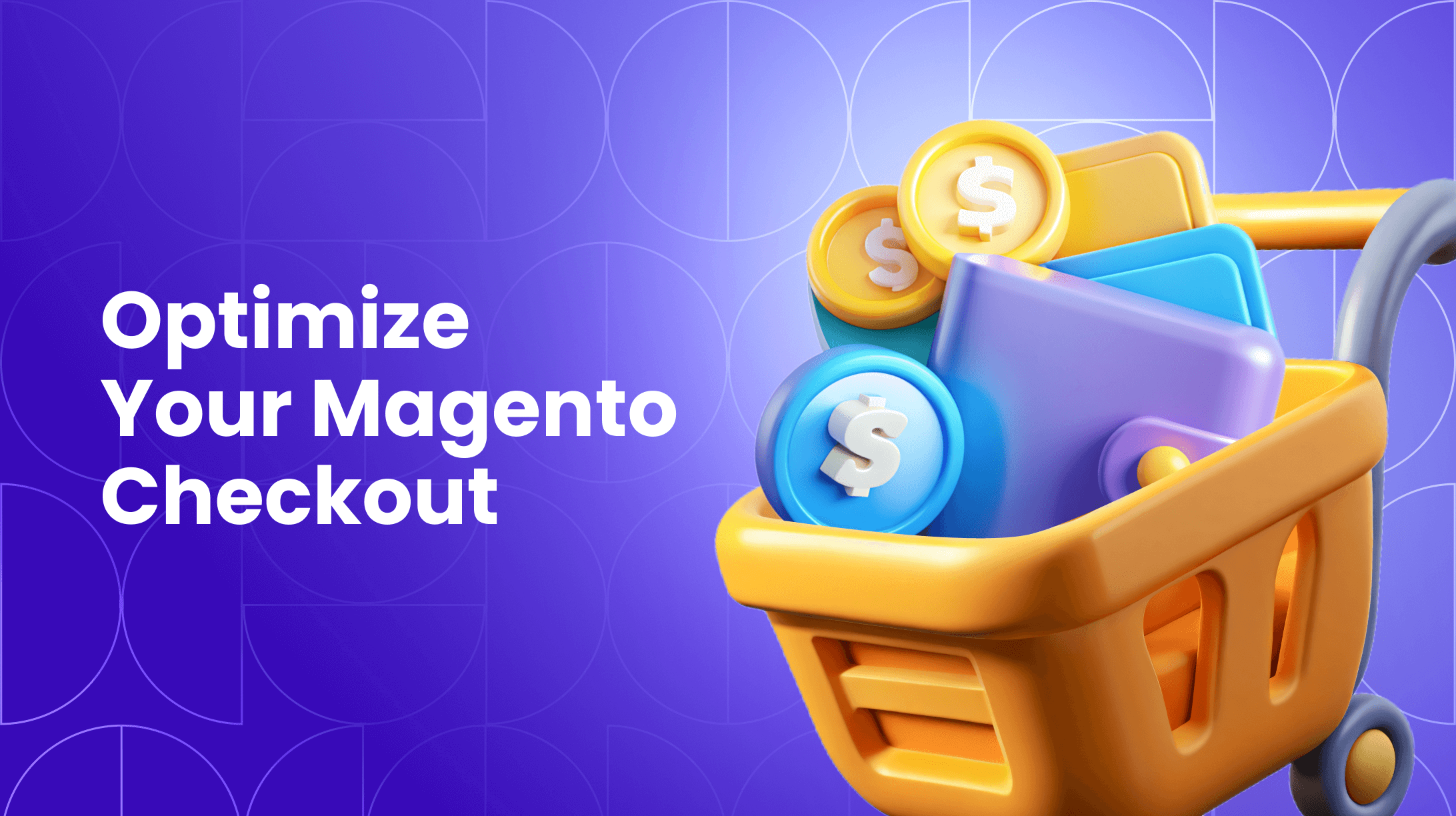0%

If there’s one page that needs to be working to ensure a successful digital shopping experience, it’s the checkout page. An outdated or confusing checkout page can completely ruin the customer journey – not to mention, it can lose you sales, too.
If you’re ready to change your Magento checkout page, you’re in the right place. This blog will help you understand how to create a Magento 2 custom checkout page to ensure the best Magento checkout experience for your customers. Read on to streamline your checkout process and boost your conversions!
Why the Magento 2 Custom Checkout Step Matters
Your checkout page is the final gatekeeper between a browsing customer and a confirmed sale. Providing a seamless, intuitive, and fast checkout experience is not just a "nice-to-have"—it is a fundamental driver of your store's profitability. A Magento 2 custom checkout is your most powerful tool for achieving this, as it allows you to meticulously add, remove, and modify components to craft an effortless path to purchase.
The stakes are incredibly high. Industry data consistently shows that the average online shopping cart abandonment rate hovers at a staggering 70.19%. This means for every ten customers who add an item to their cart, seven will leave without completing their purchase. When we dig into the reasons for this mass exodus, the checkout process is a primary culprit.
-
18% of shoppers abandon their carts after a confusing or overly long checkout experience.
-
11% abandon because the store didn't offer their preferred payment method.
-
A further 24% ditch their purchase because they were forced to create a new account.
These statistics paint a clear picture: a generic, out-of-the-box checkout costs you sales. A customized Magento checkout page directly addresses these pain points. You can eliminate confusion when you streamline the steps, build trust with prominent security features, and recover lost revenue through guest checkout and diverse payment options.

Common Magento 2 Checkout Customization Goals
Before writing a single line of code or installing an extension, you must define your "why." What specific problem are you trying to solve or what goal are you aiming to achieve? Aligning your customization efforts with a clear objective ensures every change has a purpose and a measurable outcome.
1. Increase Trust and Reduce Abandonment
The Goal: Reassure hesitant buyers who are concerned about security or the legitimacy of your store.
How to Achieve It: Embed trust signals directly into the checkout flow. This includes displaying recognized security badges (Norton, McAfee), SSL certificate seals, and money-back guarantee icons. Furthermore, showcasing clear contact information and a link to your return policy directly on the checkout page can alleviate final-minute doubts.
2. Gather Crucial Business and Marketing Intelligence
The Goal: Move beyond basic transaction data to understand your customers better and improve your marketing efforts.
How to Achieve It: Strategically add custom fields. A dropdown menu asking "How did you hear about us?" provides invaluable marketing attribution data. A simple checkbox for "Sign up for our newsletter" can grow your mailing list, but be sure it's unchecked by default to respect user preference.
3. Streamline the Process for Specific Product Types
The Goal: Remove unnecessary steps when they don't apply, creating a frictionless experience.
How to Achieve It: For stores selling virtual products, digital downloads, or services, the entire shipping information step is irrelevant. Customization can automatically hide or skip the shipping address and method steps when a cart contains only these product types, reducing the checkout to just payment and review.
4. Implement Upselling and Cross-Selling Opportunities
The Goal: Increase the Average Order Value (AOV) at the moment of maximum buyer intent.
How to Achieve It: Introduce a discreet, non-intrusive component on the payment review page. This could be a "Frequently Bought Together" suggestion, a "Last Chance" offer for a related accessory, or a prompt to add a warranty or gift wrapping for a small fee.
5. B2B Efficiency and Workflow
The Goal: Cater to the specific needs of business customers who often have more complex purchasing processes.
How to Achieve It: Customize the checkout to include a "Purchase Order (PO) Number" field. You can also pre-populate the Company Name and VAT Number fields for logged-in B2B customers, saving them time and reducing data entry errors.
How to Customize Checkout Page Magento 2
Creating a Magento 2 custom checkout page is vital to guaranteeing e-commerce success. You can customize your Magento checkout page using the following steps:
Choose Your Approach: Admin Panel vs. Extensions vs. Custom Code
The table below breaks down the three main approaches to help you decide.
| Approach | Best For | Pros | Cons |
|---|---|---|---|
| Magento Admin (For Simple Changes) | Enabling or disabling guest checkout, managing payment and shipping methods, and modifying email templates. | Built-in with no extra cost, simple and quick to configure with no technical skills required. | Very limited in layout and design changes, cannot add new fields or steps, and has minimal impact on user experience. |
| Third-Party Extensions (The Middle Ground) | Common customization needs such as adding custom fields, creating a one-step checkout, moving layout elements, or adding address autocomplete. | Faster and more cost-effective than custom code, managed via a user-friendly admin interface, with a wide variety of pre-built solutions available. | Potential for conflicts with other extensions, may slow down the site if poorly coded, and often involves a recurring cost for premium extensions. |
| Custom Code Development (For Maximum Control) | Highly specific business logic, complex integrations with other systems, or creating a completely unique checkout design. | Perfectly tailored to your specific needs and brand, offers maximum control over performance and features, with no reliance on third-party support. | Requires an experienced Magento developer, is the most expensive and time-consuming option, and must be carefully maintained to remain upgrade-compatible. |
For those opting for custom development, here are the fundamental steps:
Create a Checkout Step Component
For those who require a truly bespoke solution, custom development is the answer. The following section provides a more detailed, technical walkthrough for developers on how to add a new step to the Magento 2 checkout. This is a fundamental building block for advanced customizations.
Step 1: Add the JavaScript File
The first step is to create the view model for your new step. This is a JavaScript file that defines the behavior and logic of your step.
-
Create a New Module: All customizations should be contained within a dedicated module. Create the directory structure:
app/code/<Vendor>/<ModuleName>. -
Declare Dependencies: In your module's
registration.phpandmodule.xml, declare a dependency on theMagento_Checkoutmodule. This is crucial. -
Create the View Model: Create a new
.jsfile in your module atview/frontend/web/js/view/, for example,custom-checkout-step.js. This file will extend the default Magento checkout step component.
Example Code Snippet (custom-checkout-step.js):
Step 2: Create and Add an .HTML Template
This template defines the visual output of your step.
-
Create Template File: Create a
.htmlfile inview/frontend/web/templates/, e.g.,custom-checkout-step.html. -
Design the UI: This file contains your HTML and Knockout.js bindings. It can include form fields, informational text, or any other content required for your step.
Step 3: Add the Step to the Checkout Page Layout
Finally, you must inject your new step into the checkout page's layout.
-
Create Layout File: Create or modify the
checkout_index_index.xmlfile in your module atview/frontend/layout/. -
Declare the Component: Use XML to add your custom component to the checkout steps.
Example Code Snippet (checkout_index_index.xml):
Removing a Component
Beyond adding components for a more accessible checkout experience, Magento allows you to remove components hindering the checkout process. You can remove components from your layout rendering by creating a plugin for the method MagentoCheckoutBlockCheckoutLayoutProcessor::process.
You can implement the around method in this plugin and remove specific layout nodes at run-time.
Get in touch
with our expert
Discuss your project requirements and get a free estimate.
Get in touch
with our expert
Discuss your project requirements and get a free estimate.
Advanced Checkout Optimization Strategies
Once the fundamental structure is in place, you can leverage powerful optimization strategies to push your conversion rates even higher.
1. Implementing a One-Page Checkout
Magento 2's default checkout is already a streamlined, multi-step single-page application. However, some merchants and customers prefer a truly one-page checkout where all fields (shipping, billing, payment) are visible at once. This can be achieved through specialized extensions or custom development that re-organizes the default UI components into a single, scrollable view. The key advantage is the elimination of steps, making the process feel instantaneous for the user.
2. Leveraging Address Autocomplete
Manually typing an address is a tedious and error-prone task. Integrating with the Google Places API can transform this experience. As a user begins typing their address, a dropdown of accurate, formatted options appears. This not only improves usability but also ensures address data is clean and valid, reducing shipping errors and failed deliveries.
3. Progressive Field Disclosure
Don't overwhelm users with a form that seems too long. Use progressive disclosure to show fields only when relevant. For example, the "Company" field can be hidden by default and only appear when a user clicks an "I'm shopping for a business" checkbox. Similarly, different shipping method options can dynamically appear based on the selected country.
How to Create the Best Magento Checkout
Your checkout page is a crucial part of whether or not you make a sale, so having the best Magento checkout page possible is a must. But what makes a Magento checkout page stand out, and how can you guarantee an excellent checkout experience? Here are some expert tips.
Focus on Payment Options
Customers want flexibility in their payment options more than anything else. Giving customers several ways to pay, including non-card methods like PayPal and Venmo, will encourage them to complete their purchases, meaning higher sales volumes.
Beyond having multiple payment options, prioritize having completely secure payment methods. Show customers that you value their safety and don’t accept payments from unsecured sources.

Keep Everything User-Friendly
Many e-commerce store owners feel inclined to go overboard with their website design, throwing together elements that don’t always result in a cohesive shopping experience. Your checkout page is one of the most important places on your site, where everything should be as user-friendly and accessible as possible.
Use a simple layout and ensure your site design is mobile-responsive. Keep everything on the checkout page clear and concise, and adjust any confusing elements.
Keep Your Call to Action Noticeable
The call to action during checkout is essential to securing your sales and encouraging customers to complete their purchases. In this instance, your call to action is the checkout button, which should be featured prominently on the checkout page.
Arrange your Magento e-commerce page elements, so the checkout button is visible, and encourage users to continue shopping with statements like “proceed to checkout” before the final order placement.
Use the Guest Checkout Option
Another element you should consider adding to your Magento checkout page is a guest checkout option. One of the biggest reasons shoppers leave their shopping carts is being forced to make an account to complete a purchase, so if you don’t allow potential customers to check out as guests, you might be losing massive sales.
Add this option to your Magento checkout page to keep your customers satisfied and your sales sustainable.
Include an Order Summary
If your website doesn’t have an order summary before purchasing, adding this to your Magento checkout page can help encourage customers to complete their purchases. Order summaries are perfect additions to elevate your Magento store and enhance the customer experience.
Include details in your summary like the products, shipping costs, shipping and bill addresses, payment method, taxes, and subtotal in the order summary section – that way, customers can feel confident that their information is correct without having to start the process over.
Troubleshooting Common Magento 2 Checkout Problems
Even with careful planning and execution, issues can emerge. Here's a detailed diagnostic guide for common checkout ailments in an easy-to-reference table format.
| Problem | Root Cause | Solution |
|---|---|---|
| The "Loading" Spinner Never Finishes / Checkout is Unresponsive | Almost always a JavaScript error that halts execution of checkout scripts. Common causes include jQuery conflicts, incorrect custom JavaScript, or failed AJAX requests. | Open browser Developer Console (F12), check "Console" tab for red error messages. Disable recent extensions one by one to identify conflicts, and review custom JavaScript code for syntax errors. |
| Data from Custom Fields Isn't Saving to the Order | Backend logic to persist data from quote/checkout session to final sales order is missing or flawed. Frontend collects data but it's not properly transferred to database. | Create an observer for events like checkout_submit_all_after or a plugin extending payment method. Ensure data is explicitly saved from quote object to order object in database. |
| The Checkout Page Loads Very Slowly | Performance bottlenecks from heavy JavaScript, multiple extensions, unoptimized images, or slow server/hosting environment. Excessive third-party scripts consuming resources. | Run performance audit using GTmetrix or Pingdom. Disable non-essential checkout extensions, optimize images to WebP format, ensure Magento full-page cache and Varnish are properly configured. |
| A Specific Payment Method is Not Appearing | Payment method configuration rules not met by current order or customer. Restrictions based on country, currency, customer group, or order total thresholds. | Check Stores > Configuration > Sales > Payment Methods. Verify method is enabled for correct website, allows cart's currency, isn't country-restricted, and meets minimum/maximum order total requirements. |
| Unexpected Redirects or 404 Errors During Checkout | Corrupted URL rewrites, incorrect module configuration, or conflicts with third-party extensions modifying checkout routes. Broken links in checkout flow. | Clear Magento cache and reindex. Check for recent extension installations. Verify URL rewrites in database. Test with default Magento theme to identify theme-specific issues. |
| Shipping Methods Not Calculating or Displaying | Incorrect shipping configuration, address validation failures, or carrier service unavailability. Missing or incorrect shipping origin settings. | Verify shipping origin address in Stores > Configuration > Sales > Shipping Settings. Check carrier-specific settings (UPS, FedEx credentials). Ensure cart total meets free shipping thresholds if configured. |
| Customer Stuck in Infinite Login Loop | Session/cookie configuration issues, Varnish cache misconfiguration, or SSL/secure URL problems. Mixed content between HTTP and HTTPS. | Verify base URLs in admin panel, ensure Secure and Unsecure URLs match. Check cookie domain configuration. Test with different browsers and cleared cookies. Review Varnish configuration for proper cache exemptions. |
| Tax Calculations Not Appearing Correctly | Incorrect tax rules, product tax class assignments, or customer tax class settings. Missing or outdated tax rate information for specific regions. | Review tax rules in Stores > Taxes > Tax Rules. Verify product tax classes and customer tax classifications. Check that tax rates are updated for all shipping destinations. Test with different customer addresses. |
Optimize Magento 2 With Transform Agency
Customizing your Magento 2 checkout page is essential to guaranteeing a seamless checkout experience for your customers. Magento 2 development services like Transform Agency can help you optimize your Magento 2 e-commerce store to create a customer journey that’s effortless from start to finish.
From website customization to site optimization and SEO audits, Transform Agency has the Magento development services you need to transform the customer experience.
Contact Transform Agency today to request a quote for your next e-commerce project!
FAQ
How do I customize the checkout?
For simple field changes, use the Magento Admin under Stores > Configuration > Customers. For major layout or step changes, developer help is needed to create a custom module that safely extends the core checkout system.
How do I disable checkout?
Go to Stores > Configuration > Sales > Checkout and set "Enable Onepage Checkout" to "No." This prevents order placement, useful for maintenance or catalog sites.
Is Magento's checkout one-page?
Yes, Magento 2 uses a one-page checkout by default. Verify it's enabled in Stores > Configuration > Sales > Checkout.
How can I test checkout without real payments?
Enable "Check / Money Order" in Stores > Configuration > Payment Methods. For sandbox testing, use test card 4111 1111 1111 1111.
How do I add a custom field?
Use a "Checkout Custom Field" extension for a simple solution, or custom development involving database updates, layout changes, and JavaScript for a coded approach.
Alex excels in creating and approving customization architecture, ensuring robust and efficient solutions for e-commerce platforms. His expertise in Magento allows him to effectively manage tech resources and drive technical projects to successful completion.
Alex excels in creating and approving customization architecture, ensuring robust and efficient solutions for e-commerce platforms. His expertise in Magento allows him to effectively manage tech resources and drive technical projects to successful completion.

